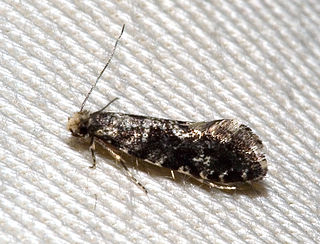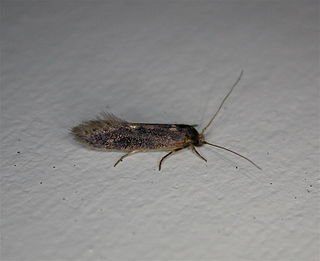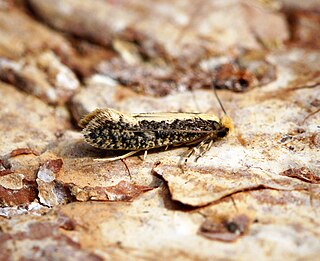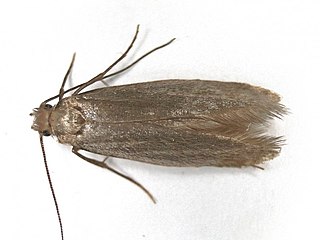
Tineidae is a family of moths in the order Lepidoptera described by Pierre André Latreille in 1810. Collectively, they are known as fungus moths or tineid moths. The family contains considerably more than 3,000 species in more than 300 genera. Most of the tineid moths are small or medium-sized, with wings held roofwise over the body when at rest. They are particularly common in the Palaearctic, but many occur elsewhere, and some are found very widely as introduced species.

Monopis imella is a moth of the family Tineidae found in Europe.

Tinea pellionella, the case-bearing clothes moth, is a species of tineoid moth in the family Tineidae, the fungus moths. This species has a cosmopolitan distribution, occurring nearly worldwide.

The brown-dotted clothes moth is a species of tineoid moth. It belongs to the fungus moth family (Tineidae), and therein to the nominate subfamily Tineinae. It is the type species of its genus Niditinea.
Cimitra is a genus of moths belonging to the family of Tineidae. Most species of this genus are found in Africa but Cimitra sechusella Walker, 1864 is found in Southeast Asia.

Agnathosia is a genus of moths belonging to the family Tineidae.
Miarotagmata is a genus of moths belonging to the family Tineidae. It contains only one species, Miarotagmata penetrata, which is found in South Africa and Zimbabwe.

Opogona omoscopa is a moth of the family Tineidae.

Monopis laevigella, the skin moth, is a species of tineoid moth. It belongs to the fungus moth family (Tineidae), and therein to the nominate subfamily Tineinae. It is the type species of the genus Monopis and its junior objective synonym Hyalospila. As with the common clothes moth, earlier authors frequently misapplied the name Tinea vestianella to the present species.

Tinea trinotella is a species of tineoid moth. It belongs to the fungus moth family (Tineidae), and therein to the nominate subfamily Tineinae. It was once used as type species of a distinct genus Acedes, but this is synonymized today with Tinea, the type genus of Tineinae, Tineidae and the superfamily Tineoidea.

Tinea is a genus of the fungus moth family, Tineidae. Therein, it belongs to the subfamily Tineinae. As evident by its name, it is the type genus of its subfamily and family. Established as one of the first subgroups of "Phalaena", it used to contain many species of Tineidae that are nowadays placed in other genera, as well as a few moths nowadays placed elsewhere.
Praeacedes is a monotypic moth genus in the family Tineidae first described by Hans Georg Amsel in 1954. Its only species, Praeacedes atomosella, was first described by Francis Walker in 1863. It has a wide range and has been recorded from Europe, Australia, Hawaii, India, Malaysia, Solomon Islands, Easter Island, Mauritius, Madagascar, Réunion, South America and North America. The species has commonly been misidentified in various parts of the world.

Monopis crocicapitella, the pale-backed clothes moth, or the bird-nest moth, is a moth of the family Tineidae described by James Brackenridge Clemens in 1859. It has a nearly cosmopolitan distribution. It was first described from the eastern United States.
Vactor Tousey Chambers was an American entomologist who specialized in Microlepidoptera. He along with James Brackenridge Clemens, was a pioneer in the study of these insects. He described many new species, with particularly many now placed in Gelechioidea.

Karsholtia is a genus of moths of the family Tineidae. The genus contains the single species Karsholtia marianii. It is found in Norway, Sweden, Denmark, Germany, Austria, France and on Sicily.

Triaxomera fulvimitrella, the four-spotted clothes moth, is a moth of the family Tineidae. It is found in most of Europe, except Ireland, the Iberian Peninsula, Italy, Slovenia and most of the Balkan Peninsula. The habitat consists of woodlands.

Tinea svenssoni is a moth of the family Tineidae. It is found in northern Europe, Russia, as well as North America where has been recorded from Québec.

Tinea columbariella is a moth belonging to the family Tineidae. The species was first described by Wocke in 1877.
Tinea dubiella is a species of moth belonging to the family Tineidae.














